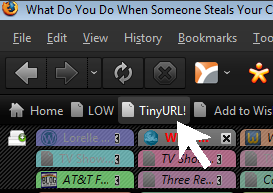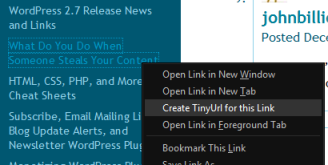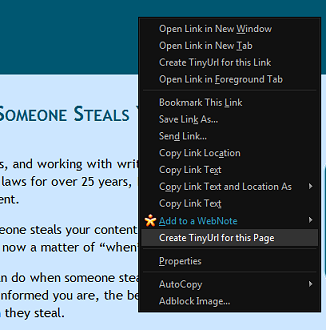Exploring Social Media: Shortening Those Links
 As I continue to explore social media and social media tools, I find myself relying more and more on URL short aliases like those produced by TinyURL. Long URL addresses are shrunk down to 8-14 characters. We’re growing more and more dependent upon information reduced to 140 characters in a world still ruled by the power of the link, and desperately seeking a way to squeeze down a long URL into as few characters as possible is a growing and competitive web app industry.
As I continue to explore social media and social media tools, I find myself relying more and more on URL short aliases like those produced by TinyURL. Long URL addresses are shrunk down to 8-14 characters. We’re growing more and more dependent upon information reduced to 140 characters in a world still ruled by the power of the link, and desperately seeking a way to squeeze down a long URL into as few characters as possible is a growing and competitive web app industry.
The need to reduce the URL on social media networks is similar to the need to compress down file sizes for transfer and backups in the earliest days of computers. WinZip, PKZIP, WinRAR, StuffIt, and others allowed us to shrink down a file to fit onto a small floppy disk, and continue to allow us backup, share, and transport large files in tiny boxes. It took a while, but soon Microsoft and Apple realized that file compression was essential and today, their operating systems include file compression.
Just as we needed to shrink our files, we now have to shrink our links. While not currently integrated into software and web apps, the day is coming when URL short aliases are coming to a web app near you. Right now, you have to settle for third-party integration.
What Do URL Aliases Have to Do With Social Media?
In the world of 140 character limits, we have to cramp everything we can into our microblogs through Twitter and other social networking microblogs and chats. Every character counts. In those few characters, we have to say a lot, and the links often get in the way.
Every day on Twitter, we write out a sentence or two in our 140 character limit and cross over the line with a warning. So we go back and edit out every “and” to “&” and remove useless or implied words (the, a, with, for, that, passive voice), editing our content to fit within the 140 character restriction.

Links eat up that precious space, further restricting what we can say. We use links to showcase posts we’ve written, recommendations, interesting discoveries, and fun. The web thrives on links. They are the finger pointers that speak loudly for who we are, what we stand for, and what we enjoy. Fitting 136 character URL address links into those recommendations doesn’t speak well for them – nor us.
One of the earliest successful ventures at URL short aliases was TinyURL (Wikipedia). Kevin Gilbertson was frustrated with the ridiculously long URL links and the ugly formatting they caused when posted to news groups, forums, in email, and even in blogs and blog comments. He wanted a way to post a long link without the ugly look and impact on the layout.
TinyURL and its competitors store the long links in a database. When the alias URL is used, it is redirected to that database and the full link is generated, displaying the page. If someone tries to make a short alias from one already in the database, the old one is used. If not, a new one is created which creates a unique fingerprint ID for each link.
The benefit for users is that the link character length is shortened. The bad news is that if one of these URL short alias databases breaks down or goes out of business, the web is left with a lot of dead mini-links.
There are a lot of pros and cons to using URL short aliases, but most of these are overlooked due to the benefits – keeping those links short.
How and When To Use URL Short Aliases
While it is nice to think of the convenience of displaying a short URL everywhere, short link aliases are not always the best choice for use in most blogs, forums, and mailing lists because they are dependent upon that database service to continue to function properly for years. Unless the link is extraordinarily long, shortened and abbreviated links are not recommended for use within your blog post content in order to ensure its timelessness.
For those chasing SEO coverage, page rank, and profit, changing a link from:
http://lorelle.wordpress.com/2006/04/10/what-do-you-do-when-someone-steals-your-content/
to
http://tinyurl.com/283dd5
takes away the SEO keyword benefits found within the link address text. In other words, the long, contextual links tell more of the story than the obscure shortened link, both to the reader and the search engine.
I tend to think of short alias links as disposable links. Links with a short life. Use them in sites and services where it isn’t important that the words within the link explain the link.
I also use them when I have no option of putting a link in an HTML Anchor tag and am stuck with link dumping, the pasting of links in comments, posts, and forums outside of the HTML Anchor tag. For example, instead of What Do You Do When Someone Steals Your Content, an easier to read and more potent link format, if the blog comments, forum, or other services won’t allow HTML, I’m forced to use the full link, which is ugly, so sometimes I’ll use a short URL instead as http://tinyurl.com/283dd5.
For social media tools, shortening the length of your links is a requirement, due to the character length restrictions. This is quickly becoming the most common usage of short URL aliases.
 To make a URL short alias, you can go to the site of a free service and copy and paste your full length link in, then generate a shortened link, copying and pasting that link in where you need it. This new short link includes a code which is the “identification” of the new URL title, a unique combination of letters and numbers linked to that link.
To make a URL short alias, you can go to the site of a free service and copy and paste your full length link in, then generate a shortened link, copying and pasting that link in where you need it. This new short link includes a code which is the “identification” of the new URL title, a unique combination of letters and numbers linked to that link.
Most URL shortening services offer a JavaScript browser bookmarklet to add a quick link to your browser. Some offer a toolbar, utility, or extension to integrate their link shortening service into the browser, speeding up the process.  Some of these browser tools add a browser toolbar shortcut, a right click menu shortcut to reduce the link of the page, and a link right click menu option to reduce that link on the page.
Some of these browser tools add a browser toolbar shortcut, a right click menu shortcut to reduce the link of the page, and a link right click menu option to reduce that link on the page.
Or you can use one of the link shortening options found in many social media networking tools, services, and third party applications.
 For instance, TinyURL allows all of the above options. You can drag a bookmarklet to your browser, or install the TinyURL Creator FireFox Extention at http://tinyurl.com/633vxr. The latest version includes “link preview” which displays the full original link in the HTML Anchor text title or alt attribute, giving the reader a chance to see the real destination link before clicking. The TinyURL Accelerator adds the option to Internet Explorer at http://tinyurl.com/5owpyn.
For instance, TinyURL allows all of the above options. You can drag a bookmarklet to your browser, or install the TinyURL Creator FireFox Extention at http://tinyurl.com/633vxr. The latest version includes “link preview” which displays the full original link in the HTML Anchor text title or alt attribute, giving the reader a chance to see the real destination link before clicking. The TinyURL Accelerator adds the option to Internet Explorer at http://tinyurl.com/5owpyn.
TinyURL Plugin for Windows Mobile adds a TinyURL function to Windows Mobile phone systems. Currently, there isn’t an iPhone app for reduced URLs, but there is method using Safari and Twitterrific that will work, if you are determined.
 TweetDeck, one of the most popular Twitter third party applications, offers 13 different URL short alias options for you to choose from to create a shorter URL. Why so many? Each one is different, and some have favorites, but also, they offer links in various lengths.
TweetDeck, one of the most popular Twitter third party applications, offers 13 different URL short alias options for you to choose from to create a shorter URL. Why so many? Each one is different, and some have favorites, but also, they offer links in various lengths.
Free URL Short Alias Services
There are a variety of short URL services available. For the most part, each one offers a web page for you to shorten a long URL. Some offer JavaScript bookmarklets, browser tools and add-ons, and other services to encourage their usage integrated within your browser or computer. Most are free but some require registration.
Be aware that many of these companies are new and might not last, a goal you want for timeless links. Some offer permanent short URLs while others may expire after a specific time period. Some either require or give you an option to create your own unique nickname or short URL as part of the shortened link. When they’ve asked, I’ve used my first name in the following examples, which means the number count includes the 7 letters of my name.
I’ve used the following link to showcase a sample of what their shortened links look like. Next to that is the number of characters within the link. Most URL shrinking programs generate the same character numbers, but ones that allow you to customize the results or use nicknames will have various lengths dependent upon what you add to the link.
http://lorelle.wordpress.com/2006/04/10/what-do-you-do-when-someone-steals-your-content/
- 6URL [http://6url.com/0B3S (20)]
- Bit.ly [http://bit.ly/sOES (17)]
- Cli.gs [http://cli.gs/BLSBAH (20)]
- Doiop [http://doiop.com/3551rh (23)]
- Fyad [http://fyad.org/wxfq (20)]
- Shorty [http://get-shorty.com/shorty/wordpress/lorelle/ (47)]
- ICanHaz [http://icanhaz.com/lorelle (26)]
- Is.gd [http://is.gd/1dxH (17)]
- Minilien [http://minilien.com/?A0Z36KTUJf (31)]
- Metamark [http://xrl.us/o2j2z (19)]
- Moourl [http://moourl.com/kexum (23)]
- NotLong [http://ethequ.notlong.com (25)]
- Pikola [http://piko.la/00fm (19)]
- Pi URL [http://piurl.com/tfF (20)]
- QurlyQ [http://qurlyq.com/1cd (21)]
- Shorl [http://shorl.com/bruledesuprivi (31)]
- Simpl.es [http://simpl.es/Lt4wW (21)]
- Tight URL [http://tighturl.com/arb (23)]
- TinyURL [http://tinyurl.com/283dd5 (25)]
- Trace URL [http://traceurl.com/rdS?r=2656&l=21 (35)
- Truly.am [http://truly.am/lorelle (23)]
- Tweetburner [http://twurl.nl/bngxdz (22)]
- URLCut [http://urlcut.com/11 (20)]
- URLvi [http://urlvi.be/gewja (21)]
- WapURL [http://wapurl.co.uk/?10OQ3MM (28)]
- TinyLink [http://tinylink.com/?w5XQkci29J (31)]
- DwarfURL [http://dwarfurl.com/2281d (25)]
- SnipURL [http://snipurl.com/7aol0 (24)]
- Spam Free Directory [http://www.iwebtool.com/shortcut/26824 (38)]
- Tiny9 [http://www.tiny9.com/u/7069 (27)]
- XAddr [http://xaddr.com/5el (20)]
Which one works best? TinyURL has been around the longest, so has the longest record of consistency. Is.gd is a favorite for many on Twitter due to the very short domain name in the URL. However, SnipURL is gaining ground.
SnipURL has a variety of options that work for power users. You can register to manage Snips and there is a Snip API for easy integration into thrid-party applications. They also have a powerful feature called Multi-Snip which allows you to reduce a number of links in one go, though I haven’t been able to get it to work due to the weak instructions and format.
LifeHacker lists “Five Best URL Shrinkers” which feature URL tracking and statistics beyond just link reduction.
You can find more URL shrinkers, reducers, and shorteners from URL Shortening Services: The Ultimate List and 32 + Short URL Maker Alternatives.
Exploring Social Media Series
- Define Social Media
- Exploring Social Media Series
- Exploring Social Media: Social Media Tools
- Exploring Social Media: It Starts With One
- Exploring Social Media: Start With the Basics
- Exploring Social Media: One Size Does Not Fit All
- Exploring Social Media: The Motrin Moment Impact of Social Media
- Exploring Social Media: Social Means Personal
- Exploring Social Media: Do You Know How to Use the Social Web?
- Exploring Social Media: Establishing Your Online Credentials
- Exploring Social Media: Learning About Social at the Goodwill Outlet
The author of Lorelle on WordPress and the fast-selling book, Blogging Tips: What Bloggers Won't Tell You About Blogging, as well as several other blogs, Lorelle VanFossen has been blogging for over 15 years, covering blogging, WordPress, travel, nature and travel photography, web design, web theory and development extensively as web technologies developed.


Very Nice, I will check some Shirting URLS out.
Oh noes! You forgot bacn.me, the most delicious of the shorteners! :)
LOL, I didn’t forget. There are dozens, with new ones coming up all the time and then others falling by the wayside. Why do you like these link shortening programs? What makes them special?
I quite like POPrl because of its statistics feature.
Thanks for the list of URL shortening services. What a great resource.
“For those chasing SEO coverage, page rank, and profit, changing a link from…takes away the SEO keyword benefits found within the link address text”
Well, not exactly. It doesn’t take away the “SEO” keyword benefit for two reasons:
1. Those links are nofollowed on Twitter anyway. Thus, no search engine benefit.
2. Truthfully, the SEO community has disagreed that there’s much SEO value to URLs at all.
Also, most of the time, your long URL will be truncated to a short URL regardless of whether you create the short URL or not.
Fortunately, some URL shortners (cli.gs does this for sure) give you the entire SEO value to links. That is, it implements a 301 redirect so that you can gain that “search equity” from using the service. Not all shortening sites do this.
“In other words, the long, contextual links tell more of the story than the obscure shortened link, both to the reader and the search engine.”
To follow the earlier point in tandem with the statement above, SEO != readability from a human standpoint. It’s important not to confuse the two.
It *does* take away the benefit for the user to determine what you’re talking about. But hopefully you’ll explain it in the other remaining characters and not in the URL.
I was talking about using short URLs on your blog, not Twitter. I’m finding more and more people using short URLs in their blog posts, and that is just too slippery a slope for me. There is a lot of value in URL text for SEO. Just do a search for WordPress and see how many people who do not blog about WordPress but for some twisted reason put /wordpress/ in their URL, making it confusing for those looking for topics specifically on WordPress. Wish there wasn’t but that’s another conversation. :D For me, readability (and functionality) means more to me than SEO stuff, so we are in agreement there.
Now http://zxc9.com six digit redirection short code. Make use of it through API also